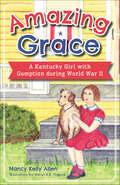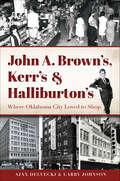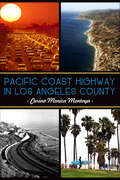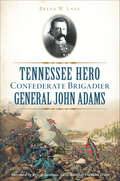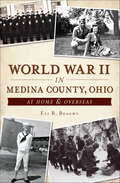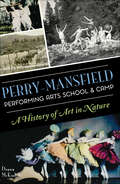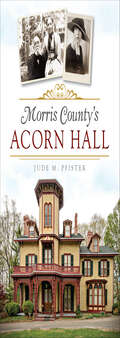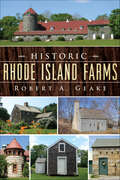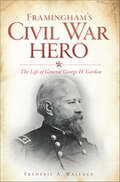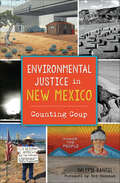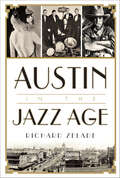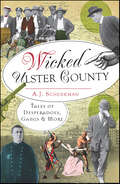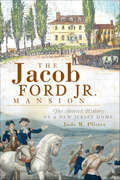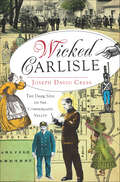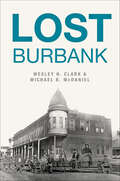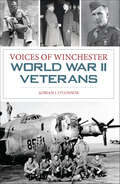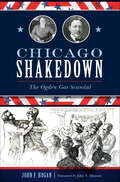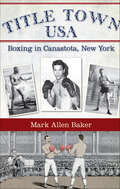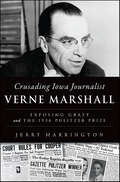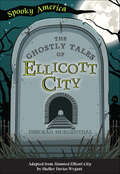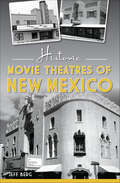- Table View
- List View
Amazing Grace: A Kentucky Girl with Gumption during World War II
by Nancy AllenEleven-year-old Grace Ann Brewer lives a normal life until her father joins the army in 1944 during World War II. When her family moves from Hazard to Ashland, Grace faces challenges entirely new to her--life without her father, fitting in at a new school and living in a new house are only a few. But a closer relationship with her grandmother, her spunky dog Spot and the letters she writes to her father overseas give her the courage she needs and the amazing strength to fight her own battles on the homefront. Author Nancy Kelly Allen tells the triumphant story of Grace's coming of age.
John A. Brown's, Kerr's & Halliburton's: Where Oklahoma City Loved to Shop (Landmarks)
by Larry Johnson Ajax DelveckiDepartment stores John A. Brown's, Kerr's and Halliburton's ruled supreme in Oklahoma City. From "lucky penny" giveaways to defying blue laws, the three big department stores did whatever it took to entertain and entice. The stunning display windows of Kerr's downtown once lured shoppers inside, but the closing of Halliburton's in 1961 signaled the final days of downtown shopping. Adoption fairs and civil rights sit-ins at Brown's wove the store into the social fabric of the city. Authors Ajax Delvecki and Larry Johnson chronicle the stories, history and memories of the best of Oklahoma City shopping.
Pacific Coast Highway in Los Angeles County (Landmarks)
by Carina Monica MontoyaThe variably named and numbered Pacific Coast Highway spans 1,700 miles from Canada to Mexico. Seventy-five of those create a dramatic drive through Los Angeles County, showcasing the iconic cities of Malibu, Santa Monica, South Bay, San Pedro and Long Beach. Past scenic seascapes and famous beaches, "PCH" has become over the decades a symbol for Southern California coastal life, encompassing pleasure piers and amusements parks, surfing, yachting and other water sports. No longer just a road, PCH is a ribbon of destinations and the byway through the California dream. Ride with author Carina Monica Montoya via vintage images from the California Department of Transportation and new photos by John Moss through this remarkable road's history and the picturesque coastal communities it serves.
Tennessee Hero Confederate Brigadier General John Adams (Civil War Series)
by Bryan W. LaneConfederate brigadier general John Adams refused to leave his men despite his own critical injuries and died at the Battle of Franklin. Until recently, his service was rarely acknowledged. During his remarkable military career, he traversed the country from Tennessee to New York, Mexico to Maryland and then to California. Adams trained and rode alongside some of the most celebrated commanders of the Confederate army, but his greatest feat remains his unwavering devotion to his men and the Confederate cause in his home state of Tennessee. Bryan W. Lane follows Adams's rise in the military ranks until his inevitable fall at one of the most important battles of the Civil War.
World War II in Medina County, Ohio: At Home & Overseas (Military)
by Eli R. BeachyFor the first time in the lives of many Medina County residents, places across the world became real, not just dots on a map. With the outbreak of World War II, men and women who had never left their corner of Ohio were encircling the globe. They were at Pearl Harbor and the Canal, Anzio and the Bulge. They built atomic bombs and bought millions in war bonds. Discover not one great hero but an entire generation of heroism. Eli R. Beachy traces the sublime story of one small community in a great, united effort--those most remarkable people of Medina County, Ohio.
Crescenta Valley Pioneers & Their Legacies
by Jo Anne SadlerTheir names run deep through local history and lore, adorning street signs, canyons, historical buildings, homes and ranches in the swath of suburbia between Pasadena and Tujunga, where the towns of La Crescenta and La Ca ada took shape, along with the unique community of Montrose. Profiled in the pages of Crescenta Valley Pioneers and Their Legacies by author Jo Anne Sadler, a researcher and frequent writer for the Historical Society of the Crescenta Valley, are such singularly important local characters as Theodor Pickens, the first permanent settler; Dr. Benjamin B. Briggs, the founder of La Crescenta; Jacob L. Lanterman and Adolphus W. Williams, the original developers of Rancho La Ca ada; and the Le Mesnager family, whose historic wine barn still stands in Deukmejian Wilderness Park.
Perry-Mansfield Performing Arts School & Camp: A History of Art in Nature (Landmarks)
by Dagny McKinleyIn 1914, Charlotte Perry and Portia Mansfield envisioned a secluded institution nestled in the mountains, where art and nature could intersect. By the 1920s, their remote Perry-Mansfield Performing Arts School & Camp in Steamboat Springs was serving as a hub for top dancers such as José Limon and Harriette Ann Gray to hone their craft. In addition to training thousands of pointed toes and arched feet, the school showcased equestrian jumping and performed plays by masters, including Shakespeare, García Lorca and Tennessee Williams. The theater program eventually attracted budding actors like Julie Harris, Dustin Hoffman and Jessica Biel. Author Dagny McKinley presents the story of America's longest continuously running performing arts camp.
Morris County's Acorn Hall (Landmarks)
by Jude M. PfisterAcorn Hall has always been a home. In 1852, Dr. John Schermerhorn conceived the sprawling estate and mansion, and he spent four years decorating it in a lavish Rococo style. Banker Augustus Crane later bought the estate and mansion, had it redesigned and rechristened it Acorn Hall, and it remained in his family through two world wars and numerous financial crises. Mary Crane Hone donated the landmark to the Morris County Historical Society in 1971. After its devoted members lovingly restored the hall, it became a focal point for the community and a beautiful setting for the society's collections. Today, it is imbued with a sense of purpose, tradition and reverence for the past. Local historian Jude Pfister tells the remarkable story of Morris County, New Jersey's Acorn Hall.
Historic Rhode Island Farms (Landmarks)
by Robert A. GeakeDating back to the colonial era, the historic barns and outbuildings of Rhode Island have withstood the test of time. From the state's early barnyard taverns to the modern-day horse and dairy farms that populate rural Rhode Island, each of these buildings has a story to tell. In the mid-eighteenth century, the Narragansett planters bred horses on their farms in southern Rhode Island. Later, dairy farms sprang up across the region. Milking barns were built on the largest farms in the state, including the Theinhert Dairy Farm and Barn in Lincoln. Before the advent of electric trolleys, urban barns sheltered horses for early tramcar transportation. Each barn is a beloved reminder of the state's history. Join author Robert A. Geake as he explores the origins and evolution of Rhode Island's farms.
Framingham's Civil War Hero: The Life of General George H. Gordon (Civil War Series)
by Frederic A. WallaceGeorge Henry Gordon, who moved to Framingham, Massachusetts, at the age of five, attended the U.S. Military Academy at West Point, where his attitudes toward the country were shaped alongside classmates George McClellan, Thomas �Stonewall� Jackson and Ulysses S. Grant. Gordon went on to hold political and military offices in the North, and as a general in the Union army, he led his troops against Jackson in the Valley Campaign, at Antietam and at the Siege of Charleston. Join historian Frederic A. Wallace as he recounts the largely untold story of General George H. Gordon, Framingham�s favorite son, with personal diary entries and letters that reveal a man of integrity and honor whose actions displayed an outright love for his country.
Environmental Justice in New Mexico: Counting Coup (Natural History)
by Valerie RangelIn New Mexico and across America, communities of color bear the brunt of contamination from generations of expansion, mining, nuclear testing and illegal dumping. The nation's largest uranium waste spill occurred in 1979 at Church Rock, and radioactivity in the Rio Puerco remains at dangerous levels. The National Trust for Historic Preservation listed Mount Taylor as one of the ten most endangered historic sites in America. After decades of sickness from Rio Grande river water, the first female governor of a Pueblo Nation, Verna Olgin Teller, led tribal members to a Supreme Court victory over Albuquerque. Valerie Rangel presents stories of strife and struggle in the war to protect the integrity of natural systems, rights to religious freedom and the continuation of traditional customs.
Austin in the Jazz Age
by Richard ZeladeThough renowned, Austin's contemporary music scene pales in comparison with the explosion of creative talent the city spawned during the Jazz Age. Dozens of musicians who started out in the capital city attained national and international fame--but music was just one form of artistic expression that marked that time of upheaval. World War I's death and destruction bred a vehement rejection of the status quo. In its place, an enthusiastic adherence to life lived without question or consequence took root. The sentiment found fertile soil in Austin, with the University of Texas at the epicenter. Students indulged in the debauchery that typified the era, scandalizing Austin and Texas at large as they introduced a freewheeling, individualistic attitude that now defines the city. Join author Richard Zelade in a raucous investigation of the day and its most outstanding and outlandish characters.
Shockoe Hill Cemetery: A Richmond Landmark History (Landmarks)
by Alyson L. Taylor-WhiteEstablished in 1822, Shockoe Hill Cemetery is the final resting place for many famous and infamous icons of Richmond. Most visited is the tomb of Chief Justice John Marshall, the longest-serving chief justice of the United States, who elevated the Supreme Court to equal standing with the executive and legislative branches of the federal government. Union spy Elizabeth Van Lew operated an extensive espionage ring during the Civil War, and though reviled in life by many who resented her activism, she rests prominently near her elite neighbors. The burial places of friends and foster family offer a glimpse into Edgar Allan Poe's personal story. Author Alyson Lindsey Taylor-White charts the history of the celebrated cemetery and brings to life the stories of those buried there.
Wicked Ulster County: Tales of Desperadoes, Gangs & More (Wicked)
by A.J. SchenkmanUncover Ulster County's hidden history of unsavory characters and stories of its wicked past.Situated in the scenic Hudson Valley, Ulster County is a lovely location to make a home and raise a family, but it wasn't always so pleasant. Unsavory characters and immoral events have sullied its name. In the 1870s, the Shawangunk Mountains inspired fear rather than awe, as groups like the Lyman Freer and Shawangunk gangs robbed and terrorized locals, descending from the protection of the wooded peaks. Kingston was torched, arson blazed in Kerhonkson and even the Mohonk Mountain House was threatened by flames. In 1909, the Ashokan Slasher's bloody crimes and sensational trial captured headlines across the country. Discover these and other salacious stories buried in Ulster County's history.
The Jacob Ford Jr. Mansion: The Storied History of a New Jersey Home (Landmarks)
by Jude M. PfisterIn 1772, the Ford family began building what would easily become the largest home in Morristown and years laterbecame the site of the first National Historic Park in the United States. Completed just before colonial unrest reached a boilingpoint, the home quickly secured a reputation as a place of prominence for supporters of colonial interests. Today, the mansion is best known as George Washington's headquarters,when it became a strategic site for Washington during a winter encampment and gained importance for its role in the American Revolution. Jude Pfister tells the story of this beloved home that has endured the tests of time and whose own history is inextricably woven into that of the country's.
Wicked Carlisle: The Dark Side of the Cumberland Valley (Wicked)
by Joseph David CressWith Wicked Carlisle, author Joe Cress revisits the criminal history of Cumberland County. Taking a more focused and less bloody approach, Cress will largely bring new stories of mischief to the table, though he will revisit the lighter side of two or three crimes from Murder and Mayhem in Cumberland County. From stories of college pranks gone wrong, Carlisle's own Robin Hood and the robbing and subsequent torching of a beloved local theater (the Strand where the local HS now sits ) to abuses at the Carlisle Indian School and the town's connection to the raid on Harper's Ferry, Cress scours the underbelly of the borough for mischief and misdeeds.
Forgotten Chicago Airfields
by Nicholas C. SeligNick Selig excavates the highways to the sky that have been covered up by urban sprawl or dissolved by neglect. More than a guide to landing strips that have had startling second lives as shopping malls or retirement homes, he uncovers the excitement of the early days of air travel, when a man might cling to his job as a lavatory truck driver for a closer peek at aviation. In this follow-up to "Lost Airports of Chicago," discover how a tractor swap gave birth to Clow International Airport and revel in the daredevil exploits of puddle-jumper pilots over the wide-open spaces of Harlem Avenue.
Lost Burbank (Lost)
by Wesley H. Clark Michael B. McDanielSlowly fading with the city's ever-changing landscape, the places and people of Burbank's past tell a vibrant story. Before the arrival of Warner Bros. and Walt Disney, First National Pictures built its original studio lot on Olive Avenue in 1926. For over sixty years, Lockheed Aircraft Company produced some of the nation's best airplanes where the massive Empire Shopping Center now stands. Heavyweight champion James Jeffries turned his Burbank ranch home and barn into a beloved landmark and boxing venue. And inventor Joseph Wesley Fawkes's scheme to build a monorail to Los Angeles became a local laughingstock. Die-hard Burbankers Wes Clark and Michael McDaniel collect these and many more forgotten local stories where they can finally be found.
Voices of Winchester World War II Veterans (American Chronicles)
by Adrian J. O'ConnorStories of the Greatest Generation come alive in the hands of longtime local journalist Adrian O'Connor What made the D-Day attack on Omaha Beach so remarkable was that it was carried out largely out by National Guardsman - men of the 29th Infantry Division who had never before seen combat. One of the companies that was part of this historic day hailed from the environs of Winchester, Virginia. Winchester's martial gallantry was hardly restricted to the beaches of Normandy, though. A future city councilor came ashore at Anzio, Italy. A future school principal fought in what may have been the Pacific's toughest battle, Iwo Jima. Local men held the line at the climactic Battle of the Bulge, flew over Europe and the oil fields of Ploesti and even escaped a German prisoner-of-war camp.
Chicago Shakedown: The Ogden Gas Scandal
by John F. HoganThe Ogden Gas Affair represented the biggest political scandal of Chicago's first sixty years. Mayor John P. Hopkins and Democratic Party boss Roger Sullivan conspired with ten other insiders to form a dummy corporation to blackmail Peoples Gas Company. The scam poured money into the coffers of beneficiaries who were never prosecuted, including the governor of Illinois, John P. Altgeld. As their lengthy swindle ran its course, Hopkins and Sullivan rubbed elbows with the most notorious grafters of the robber baron era, including Charles Yerkes and "Big Bill" Thompson. Author John Hogan follows the money in a scheme that became a template for the enrichment of the connected at the expense of the citizenry.
East of Boston: Notes from the Harbor Islands
by Stephanie SchorowFor the traveler who might not have a yacht�just a sense ofhumor and a spirit of adventure�Stephanie Schorow proves you can still embark on a voyage through the Boston Harbor Islands. A practical guide, complete with camping tips and driving directions, East of Boston�s droll travelogue takes the measure of these gloriously wild Edens all within sight of the city�s skyline. Join Schorow around a campfire for some friendly conversation about pirate treasure, elusive foxes, cross-dressing ghosts, flying Santas and a strange era of spontaneously combusting garbage dumps. And if you are truly brave, perhaps take a sip of the park ranger�s �Sumac-ade.�
Title Town USA: Boxing in Canastota, New York
by Mark Allen BakerCanastota, New York, at the epicenter of Upstate New York's rich boxing heritage, is home to the International Boxing Hall of Fame. Having produced some of boxing's most prominent pugilists, including Carmen Basilio and Billy Backus, the area has also hosted many legendary fighters, including Jack Britton, Harry Greb, Sam Langford and Tommy Ryan. Many boxing dreams have come true here through title fights and epic ring rivalries. Author Mark Allen Baker tells the story of those "thunder gods of the ring" and the fights that made them famous, finally settling the score: Canastota is "Title Town, USA."
Crusading Iowa Journalist Verne Marshall: Exposing Graft and the 1936 Pulitzer Prize
by Jerry HarringtonOn December 12, 1934, police raided a canning factory in Cedar Rapids, uncovering an illegal liquor and gambling set-up. Verne Marshall, tempestuous editor of the Cedar Rapids Gazette, sensed a bigger story and a wider network of corruption. His aggressive investigative reporting led to multiple resignations, nearly fifty indictments and the dramatic trial of the state's attorney general. These explosive exposés earned Verne Marshall and the paper the 1936 Pulitzer Prize. Author Jerry Harrington traces the legacy of Marshall's incendiary crusade across Iowa's political landscape.
The Ghostly Tales of Ellicott City (Spooky America)
by Deborah MorgenthalGhost stories from Ellicott City, Maryland have never been so creepy, fun, and full of mystery! The haunted history of Ellicott City comes to life—even when the main players are dead. Visit the Third Ellicott City Firehouse and catch a glimpse of the people who died in the tragic fire that occurred there. Or step inside the ruins of Patapsco Female Institute, and be sure to keep an eye out for the ghoulish girls that may be running around! Dive into this spooky chapter book for suspenseful tales of bumps in the night, paranormal investigations, and the unexplained; just be sure to keep the light on.
Historic Movie Theatres of New Mexico (Landmarks)
by Jeff BergNew Mexico's theatrical ties span over one hundred years. The Fountain Theatre, once a Civil War hospital and headquarters, produced plays, opera and vaudeville performances until 1929, when the venue started airing talkies. Today, it holds the title of oldest operating theatre in New Mexico. Albuquerque drive-in attendees enjoyed personal screens for each car at the Circle Autoscope. And Rio Grande Theater operated for over seventy years before showing its final screening of U.S. Marshals in 1998. Author Jeff Berg details the Land of Enchantment's iconic movie houses.
